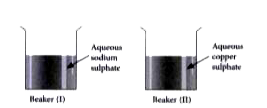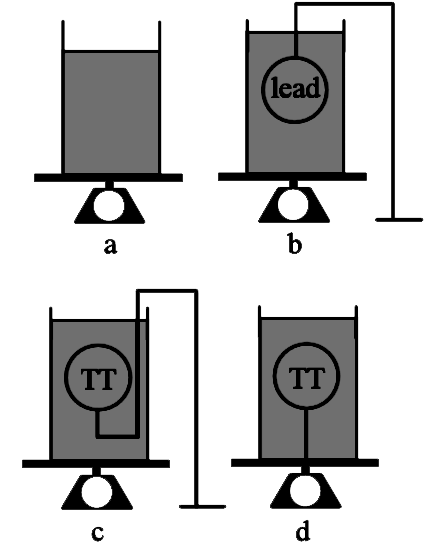I have understood the reactions taking place in beakers 'A' and 'B'. But I am still confused why there is no change in beakers 'C', 'D' and 'E'?
The correct Answer is:Copper is not able to replace zinc from zinc sulphate, therefore we are not able to see any change in beaker'C'.
Similarly, no replacement occurs in beaker 'D' and 'E'.
Similar Questions
Classify the following as open, closed, or isolated system.
a. A beaker containing as open, boiling water.
b. A chemical reaction taking place in an enclosed flask.
c. A cup of tea placed on a table.
d. Hot water placed in perfectly insulated closed container.
e. A thermos flask containing hot coffee.
View SolutionPaheli prepared a blue coloured solution of copper sulphate in beaker A and placed an iron nail in it. Boojho prepared a yellowish green solution of ferrous sulphate in beaker B and placed a copper wire in it. What changes will they observe in the two beakers after an hour?
View Solution
Knowledge Check
Identify the type of reaction taking place when water is added slowly to a small amount of calcium oxide in a beaker is:
(I) Exothermic reaction.
(II) Endothermic reaction
(III) Combination Reaction
(IV)Displacement reactionABoth (I) and (III)BBoth (II) and (III)CBoth (I) and (IV)DBoth (II) and (IV)Three beakers labelled as A, B and C each containing 25 mL of water were taken. A small amount of NaOH, anhydrous CuSO4 and NaCl were added to the beakers A, B and C respectively. It was observed that there was an increase in the temperature of the solutions contained in beakers A and B, whereas in case of beaker C, the temperature of the solution falls. Which one of the followig statement (s) is (are) correct?
1. In beakers A and B, exothermic process has occurred.
2. In beakers A and B, endothermic process has occurred.
3. In beaker C, exothermic process has occurred.
4. In beaker C, endothermic process has occurred.AOnly (i)BOnly (ii)C(i) and (iv)D(ii) and (iii)Three beakers labelled as A, B and C each containing 25 mL of water were taken. A small amount of NaOH, anhydrous CuSO4 and NaCl were added to the beakers A, B and C respectively. It was observed that there was an increase in the temperature of the solutions contained in beakers A and B, whereas in case of beaker C, the temperature of the solution falls. Which one of the following statement(s) is (are) correct ?
(i) In beakers A and B, exothermic process has occurred.
(ii) In beakers A and B, endothermic process has occurred.
(iii) In beaker C exothermic process has occurred.
(iv) In beaker C endothermic process has occurred.A(i) onlyB(ii) onlyC(i) and (iv)D(ii) and (iii)
Classify the following as open, closed, or isolated system.
a. A beaker containing as opne, boiling water.
b. A chemical recation taking place in an enclosed flask.
c. A cup of tea placed on a table.
d. Hot water placed in perfectly insulated closed container.
e. A thermos flask containing hot coffee.
View SolutionTake two identical 100cm3 beakers. Fill one beaker completely with water and the other with kerosence oil. Place the beakers in the scale pans of an ordinary beam balance. It is observed that the beaker filled with water have more mass than the beaker filled with kerosene oil. This is because
View SolutionMagnesium powder was added to two different salt solutions in beakers (I) and (II) as shown in the given figures. Answer the questions that follow:

Write an equation for the reaction that takes place.
View SolutionI am taking a book with me so that I'll have something to read on the train
View SolutionFour identical beakers contain same amount of water as shown below. Beaker 'a' contains only water. A lead ball is held submerged in the beaker 'b' by string from above. A same sized plastic ball, say a table tennis (TT) ball, is held submerged in beaker 'c' by a string attached to a stand from outside. Beaker 'd' contains same sized TT ball which is held submerged from a string attached to the bottom of the beaker. These beakers (without stand) are placed on weighing pans and register reading Wa,Wb,Wc and Wd for a, b, c and d, respectively. (Effects of the mass and volume of the stand and string are to be neglected)

View Solution
